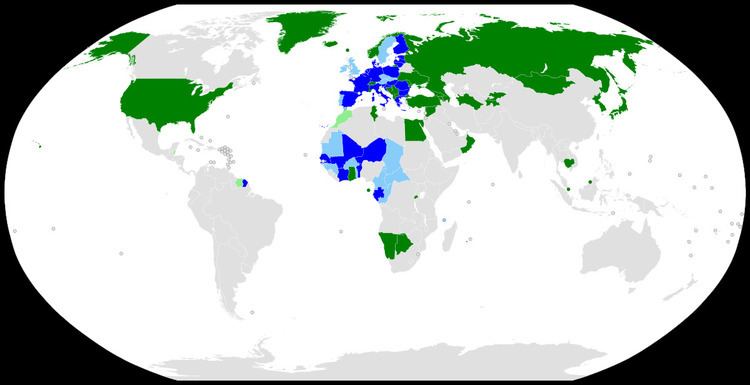Parties 66 | Effective 1 June 1928 | |
 | ||
Signed 6 November 1925 (The Hague Agreement)2 June 1934 (London act)14 July 1967 (The Hague Act/Stockholm addnl Act)2 July 1999 (Geneva Act) Depositary Switzerland (1925/1934)Netherlands (1960)WIPO | ||
The Hague Agreement Concerning the International Deposit of Industrial Designs, also known as the Hague system provides a mechanism for registering an industrial design in several countries by means of a single application, filed in one language, with one set of fees. The system is administered by WIPO.
Contents
Instruments
The Hague Agreement consists of several separate treaties, the most important of which are: the Hague Agreement of 1925, the London Act of 2 June 1934, the Hague Act of 28 November 1960 (amended by the Stockholm Act), and the Geneva Act of 2 July 1999.
The original version of the Agreement (the 1925 Hague version) is no longer applied, since all states parties signed up to subsequent instruments. The 1934 London Act formally still applies between a London act state that did not sign up to the Hague and/or Geneva Act in relation with other London act states (Suriname and Benin in relation to the other London states). Since 1 January 2010, however, the application of this act is frozen and it will formally cease to be in force by October 2016 following notifications of all contracting parties.
Countries can become a party to the 1960 (Hague) Act, the 1999 (Geneva) Act, or both. If a country signs up to only one Act, then applicants from that country can only use the Hague system to obtain protection for their designs in other countries which are signed up to the same Act. For instance, because the European Union has only signed up to the 1999 (Geneva) Act, applicants which qualify to use the Hague system because their domicile is in the European Union can only get protection in countries which have also signed up to the 1999 Act or to both the 1999 and 1960 Acts.
Contracting Parties (member countries)
All contracting parties to one or more of the instruments of the Hague Agreement are members of the Hague Union. A list is shown below:
A list of the Contracting Parties is maintained by WIPO.
Qualification to use the Hague system
Applicants can qualify to use the Hague system on the basis of any of the following criteria:
An applicant who does not qualify under one of these headings cannot use the Hague system. The Contracting Parties include not only individual countries, but also intergovernmental organisations such as the African Intellectual Property Organization (OAPI) and the European Union. This means an applicant domiciled in an EU member country that is not a Contracting Party, such as Austria or the United Kingdom, can nevertheless use the Hague system on the basis of his or her domicile in the European Union.
Application requirements
An application may be filed in English, French, or Spanish, at the choice of the applicant. The application must contain one or more views of the designs concerned and can include up to 100 different designs provided that the designs are all in the same class of the International Classification of Industrial Designs (Locarno Classification).
The application fee is composed of three types of fees: a basic fee, a publication fee, and a designation fee for each designated Contracting Party.
Examination and registration procedure
The application is examined for formal requirements by the International Bureau of WIPO, which provides the applicant with the opportunity to correct certain irregularities in the application. Once the formal requirements have been met, it is recorded in the International Register and details are published electronically in the International Designs Bulletin on the WIPO website.
If any designated Contracting Party considers that a design which has been registered for protection in that Contracting Party does not meet its domestic criteria for registrability (e.g. it finds that the design is not novel), it must notify the International Bureau that it refuses the registration for that Contracting Party. In every Contracting Party that does not issue such a refusal, the international registration takes effect and provides the same protection as if the design(s) had been registered under the domestic law of that Contracting Party.
Duration & renewal
The duration of an international registration is five years, extendable in further five-year periods up to the maximum duration permitted by each Contracting Party. For the 1934 London Act the maximum term was 15 years.
Renewals are handled centrally by the International Bureau. The applicant pays a renewal fee and notifies the International Bureau of the countries for which the registration is to be renewed.
Naming
The agreement was concluded at the Dutch city The Hague.
